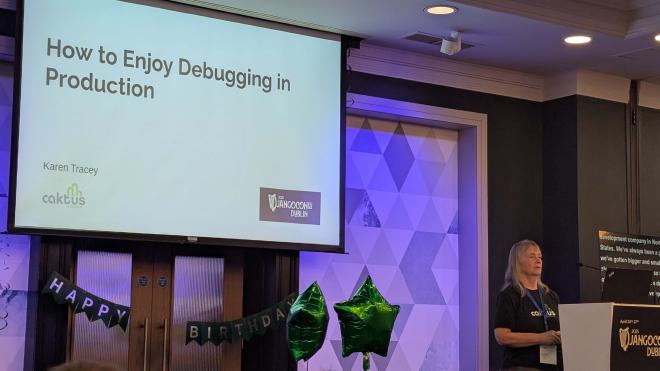DjangoCon Europe 2025 Highlights

Three Cakti recently attended DjangoCon Europe 2025 in Dublin and it was a wonderful experience! It was great to see and chat with various Django community members we usually only see once or twice a year. Beyond that, we were most impressed by the consistently high quality of the talks throughout all three days of the conference. It was a pleasure to listen to so many excellent presentations, including the lightning talks at the end of each day. Here are some of our favorite talks.
Karen Tracey
It is hard to pick out a single favorite, so I am going to mention a few:
Tim Bell from Kraken Technologies Australia gave a talk on Converting integer fields to bigint using Django migrations at scale, followed up by a lightning talk a couple of days later that revealed how the real life production situation which was the inspiration for the talk was quite a near thing and required some daring creativity to sidestep disaster. I hope never to be in a similar situation but I do find talks on solving challenging production problems very enjoyable.
In a similar vein, Mia Bajić presented a keynote on The Most Bizarre Software Bugs in History which was fascinating. One takeaway: integration tests are invaluable and could have saved the NASA Mars Climate Orbiter from disaster. They probably wouldn’t have added that much to the $327 million cost either.
Finally, I enjoyed Graham Knapp’s talk on Feature Flags: Deploy to some of the people all of the time, and all of the people some of the time!. I particularly appreciated Graham’s focus on the need to clean up the flags when they’ve outlived their usefulness. Keeping with the theme of my favorite talks from the conference, Graham noted that re-use of a feature flag had led to massive financial loss for a high frequency trading company several years ago.
Tobias McNulty
The talks Karen mentioned are some of my favorites, too, but I’ll try to pick out a few more!
Sarah Boyce kicked off the conference with a keynote titled Why Django Need’s You! (to do code review). I learned that the average time to merge a PR in Django is 319 days (!). I posted a summary of the key steps on LinkedIn. I encourage you to check them out and help spread the word!
Karen Jax’s talk on the Anatomy of a Database Operation was also fascinating. Understanding the steps that the database goes through to “1. Parse, 2. Transform & Rewrite, 3. Plan, and 4. Execute” a query is helpful when debugging or reading query plans. The video of the talk isn’t available yet, but she gave another talk on Tuning PostgreSQL to work even better at DjangoCon 2023 which is on my list to watch.
Lastly, Agnès Haasser gave a talk titled Europe, Django and two-factor authentication that went in depth on the standards and best practices for multifactor authentication. I particularly appreciated the quote, “You should worry about [multi-factor authentication] before your customer [or employer] asks you to, because when they do, it will be too late.” I also posted this on LinkedIn, and I encourage you to advocate for multi-factor authentication wherever and whenever it may be needed!
Colin Copeland
To add to the talks above, I also enjoyed the following:
Haki Benita spoke on How to get Foreign Keys horribly wrong in Django. I appreciated his recommendation to always check the SQL generated by migrations, using sqlmigrate, to ensure that the expected changes are being made to the database schema. Also, \di+ in psql is a great way to see the indexes on a table, including the foreign keys and sizes of the indexes.
How we make decisions in Django by Carlton Gibson was a great talk about the decision-making process in Django. He highlighted many topics, including the challenges presented by pushing more code into core vs keeping it in third-party packages, and the trade-offs involved in each approach. His discussion on thinking of community as trust resonated with me. In smaller groups, trust is easier, but that changes when groups grow larger. I appreciated his ideas around smaller working groups and bringing back the space for trust in larger communities.
Lastly, I also enjoyed Django for Data Science: Deploying Machine Learning Models with Django by William Vincent. Having only dabbled in training models with sample datasets from Hugging Face, I appreciated the overview of the process of not only deploying a model with Django, but also the basics of using the model to make predictions in a web context.
Conclusion
Finally, we’d be remiss for not mentioning Karen’s talk, How to Enjoy Debugging in Production. Be sure to check it out once a video is available!
DjangoCon Europe 2025 was well worth the (long) trip for us, and we encourage anyone who was unable to attend the conference to check out these (and all the other) talks online once they become available!